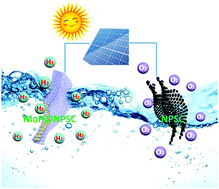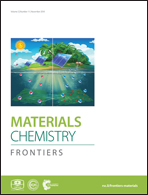Ultrafine molybdenum phosphide nanocrystals on a highly porous N,P-codoped carbon matrix as an efficient catalyst for the hydrogen evolution reaction†
Abstract
High-performance and affordable electrocatalysts from earth-enriched materials are desirable for many sustainable energy conversion and storage systems. Highly crystalline MoP nanocrystals with ultrasmall sizes embedded in an N,P-codoped carbon matrix (MoP@NPCS) were designed and fabricated for hydrogen evolution. Due to the highly active catalytic nature of the MoP nanocrystals, the ultrasmall MoP nanoparticles on the conductive carbon matrix, the high surface area of the carbon matrix with abundant N and P dopants, and the strong coupling effect between the MoP nanoparticles and the carbon matrix, the designed MoP@NPCS catalysts show excellent hydrogen evolution behaviour, with an onset potential of −47 mV and an overpotential of 107 mV, to achieve a current density of 10 mA cm−2 in 1.0 M KOH, along with robust operational durability. Specially, the fabricated N,P-codoped carbon matrix (NPCS) exhibits high OER catalytic activity with an overpotential of 390 mV to afford 10 mA cm−2 and excellent stability. Finally, a two-electrode electrolyzer using MoP@NPCS and NPCS as the cathode and anode electrodes, respectively, requires a low voltage of 1.70 V to achieve 10 mA cm−2 over long-term operation. Due to this impressive performance, MoP@NPCS is a promising electrocatalyst for practical hydrogen production from electrocatalytic water splitting.

- This article is part of the themed collection: Materials Chemistry Frontiers HOT articles for 2018


 Please wait while we load your content...
Please wait while we load your content...